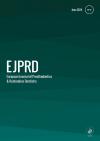European Journal of Prosthodontics and Restorative Dentistry
Effect of Artificial Aging on Translucency of Zirconia Reinforced Lithium Silicate and Lithium Disilicate Ceramics: A Systematic Review
Abstract
Introduction: Digital dentistry and advanced ceramic materials have been widely used but which material has a better esthetically durable outcome needs to be evaluated. The purpose of this systematic review and meta-analysis was to evaluate the difference in the translucency of CAD zirconia-reinforced lithium silicate and CAD lithium disilicate glass ceramics after being subjected to artificial aging. Material and Methods: Two independent reviewers searched the MEDLINE/ PubMed, Embase, and EBSCO databases and the Google Scholar search engine for in-vitro studies published from January 2010 to May 2023 to identify relevant studies measuring the translucency of CAD ZLS and CAD lithium disilicate glass ceramics after being subjected to different artificial aging conditions using the coffee solution, 4% acetic acid, distilled water and UV aging. Results: For qualitative synthesis, 10 studies were included. A statistically significant difference was observed between CAD zirconia-reinforced lithium silicate and CAD lithium disilicate glass ceramics (P<0.05, mean difference=-0.25 [-0.38,-0.11]). Translucency of CAD ZLS was less than CAD lithium disilicate glass ceramics. Conclusions: Artificial aging has decreased the translucency of glass ceramics. For fixed prosthetic rehabilitation clinicians can opt for CAD lithium disilicate glass-ceramic as a more esthetically pleasing and durable material in oral environment.
Keywords
Glass Ceramics
Translucency
Computer-Aided Manufacturing
Lithium Disilicate
Zirconia Reinforced Lithium Silicate
Computer-Aided Designing
Authors
Dr Shruti Potdukhe, Dr Janani Iyer, Dr Akash More
Articles from this issue
 Free Access
Free Access No Access
No Access Full Access
Full Access


